Wolverhampton railway station
Wolverhampton railway station in Wolverhampton, West Midlands, England is on the Birmingham Loop of the West Coast Main Line. It is served by Avanti West Coast, CrossCountry, Transport for Wales and West Midlands Trains services, and was historically known as Wolverhampton High Level.
| Wolverhampton | |
|---|---|
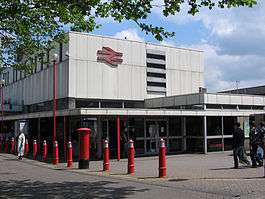 The former station building of 1964-67 by Ray Moorcroft Demolished in 2020 | |
| Location | |
| Place | Wolverhampton |
| Local authority | City of Wolverhampton |
| Coordinates | 52.5875°N 2.1200°W |
| Grid reference | SO919988 |
| Operations | |
| Station code | WVH |
| Managed by | West Midlands Railway[1] |
| Number of platforms | 6 |
| DfT category | B |
| Live arrivals/departures, station information and onward connections from National Rail Enquiries | |
| Annual rail passenger usage* | |
| 2014/15 | |
| 2015/16 | |
| 2016/17 | |
| 2017/18 | |
| 2018/19 | |
| Passenger Transport Executive | |
| PTE | Transport for West Midlands |
| Zone | 5 |
| History | |
| Original company | Birmingham, Wolverhampton and Stour Valley Railway |
| Pre-grouping | London and North Western Railway |
| Post-grouping | London, Midland and Scottish Railway |
| 1 July 1852 | Opened as Wolverhampton (Queen Street) |
| 1 June 1885 | Renamed Wolverhampton (High Level) |
| 7 May 1973 | Renamed Wolverhampton |
| National Rail – UK railway stations | |
| |
History
The first station named Wolverhampton had opened on the edge of the town centre in 1837 on the Grand Junction Railway, this station was renamed Wednesfield Heath in 1855, shortly after the present station was opened, and then was closed in 1873.[2]
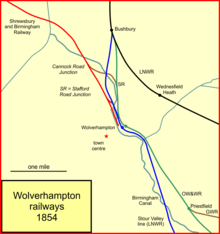
On 12 November 1849, the Shrewsbury and Birmingham Railway opened a temporary terminus to its line, at a location very close to the present station.[3]
The present station was opened on 1 July 1852 by the Birmingham, Wolverhampton and Stour Valley Railway, a subsidiary of the London and North Western Railway (LNWR); it was named Wolverhampton Queen Street.[4] The only visible remnant of the original station is the Queen's Building, the gateway to Railway Drive which was the approach road to the station. The building was originally the carriage entrance to the station and was completed three years before the main station building. Today, it forms part of Wolverhampton bus station.[5]
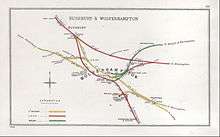
Two years later, on 1 July 1854, the Oxford, Worcester and Wolverhampton Railway (OWWR) opened a second station, located behind the older station on lower ground, which became known as the Wolverhampton Low Level station from April 1856, the other becoming known as Wolverhampton High Level from 1 June 1885.[4]
From 1923, the LNWR was amalgamated into the London Midland and Scottish Railway (LMS), and in 1948 it became part of the London Midland Region of British Railways.[6]
Services over the former Grand Junction Railway line to Walsall (and thence to Lichfield City and Burton-on-Trent) ended in January 1965, this route being the only one from here to fall victim to the Beeching Axe.
The present Wolverhampton station dates from 1964-67[7] when the High Level station was completely rebuilt by the architect Ray Moorcroft as part of the modernisation programme which saw the West Coast Main Line electrified.[5] It consisted of three through platforms (the present platforms 1, 2 and 3). As part of this scheme, most services on the OW&WR route from Shrewsbury were diverted here from Low Level (though a few peak-hour trains continued to serve the latter until March 1968); these then continued to Birmingham New Street via the Stour Valley line rather than via the ex-GWR line to Birmingham Snow Hill as before. In the 1980s, a parcels siding was converted into a south-facing bay platform (the present platform 5), and a new north-facing bay was constructed (the present platform 6).
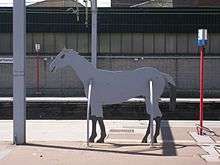
In 1987 twelve different horse sculptures by Kevin Atherton, titled Iron Horse, were erected between New Street station and Wolverhampton, including one at the southern end of platforms 2 and 3.[8]
More recently (in 2004), a new through platform (platform 4) was constructed on the site of infrequently-used sidings. This has greatly enhanced the capacity of the station. A new footbridge was also constructed, to allow access to the new platform but also to improve access to the existing ones. A proposal for a more comprehensive redevelopment of the station and surrounding area was announced on 18 October 2006.[9]
Work on this is expected to be completed in September 2020 and will include an extension of the Midland Metro.
Management of the station transferred from Virgin Trains West Coast to West Midlands Trains franchise in April 2018.[10]
Services
Typical weekday operations are as follows:[11]
- 1tph to London Euston via Birmingham New Street (more in the morning peak)[12]
- 1tph to Scotland, alternating every two hours between Glasgow Central and Edinburgh. These start or terminate at Carlisle or Preston or Lancaster or Crewe during peak hours.
- 2 trains per day to Shrewsbury.
- 2tph to Liverpool Lime Street, start/terminating at Crewe or Stafford in the peak hours
- 2tph to Birmingham New Street
- 4tph to Birmingham New Street, of which two continue to Walsall
- 2tph to Shrewsbury, one calling all stations, and the other as a limited stop semi-fast express. Sundays are operated as an hourly service stopping at all stations.[13][14]
- 2tph to Manchester Piccadilly, via Stoke-on-Trent & Macclesfield (a limited service also runs via Crewe)
- 2tph to Birmingham New Street, extending to various parts of southern England, such as Bristol Temple Meads, Exeter St Davids, Reading, Southampton Central and Bournemouth.[15]
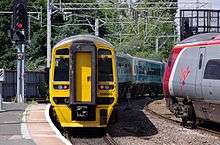
Transport for Wales:
- 1tp2h to Pwllheli & Aberystwyth, dividing at Machynlleth
- 1tp2h to Holyhead via Shrewsbury and Chester
- 1tph to Birmingham International[16]
West Midlands Railway also run a single Saturdays-only parliamentary train on the line to Walsall via Pleck (the former Grand Junction Railway route that continues to New Street via Aston). This replaced the regular direct service that ran between 1998 and 2008 (when it was withdrawn due to low usage). Centro (now called Network West Midlands) hoped to reintroduce a regular service over the line in the future (ideally when the West Midlands area franchise comes up for renewal in 2016/7)[17] and reopen the old station at Willenhall, though it would require some infrastructure improvements here to accommodate it (i.e. a new bay platform & associated signalling).
Platforms

Wolverhampton station has six platforms: platforms 1 to 4 are through platforms, while platforms 5 and 6 are bay platforms at the south and north ends respectively. Although all four through platforms are reversible, in practice platform 1 is used for northbound services, platform 2 for northbound and southbound services, and platforms 3 and 4 are for southbound services. Platform 3 is also used for northbound services at busy times. Platform 5 is used by local services to Walsall via Birmingham New Street. Platform 6 was designed for local services on the Wolverhampton to Shrewsbury Line (and was formerly numbered Platform 4 but was renumbered upon the construction of the present Platform 4 in 2004) but is now rarely used, as the majority of services on that route travel through to Birmingham (or occasionally to Walsall). It is generally used for the first service of the day to Shrewsbury and for holding trains when they are not in use.
Platform 1 is mostly used for northbound services, however in the late evenings and on Sundays, there are still a few Avanti West Coast shuttle services that either terminate in platforms 1 or 2. These shuttle trains, usually travel to London Euston, via Birmingham New Street. The shuttle trains are usually of 9-car formation.
Platform 2 is now used for all Virgin Trains services from Edinburgh/Glasgow to London Euston. The timetable change on 8 December 2013 saw Virgin Trains running an hourly timetable from Scotland to Euston via the West Midlands and vice versa, replacing the Wolverhampton - Euston service.
All platforms at the station are electrified to 25 kV AC overhead power.[18]
The Interchange Project
The railway station is earmarked for redevelopment as part of the Wolverhampton Interchange Project. Ion Developments (previously Neptune Developments) were selected for the project and plan to create a major mixed used area that includes both bus and railway stations, a hotel, retail outlets, bars, cafes and offices.
The plan is to completely rebuild the railway station and improve pedestrian access over the ring road, with a new footbridge link direct to the bus station. After a shortfall in funding for the project, it was decided that the development would take place in phases. Phase One began in April 2010 with the construction of the new bus station which was completed in 2011. Phase Two, which includes the railway station, canalside development, and a hotel, has commenced as of September 2018.[19]
On 31 December 2014 the first phase of the redevelopment of the Railway Station was announced, with the redevelopment of the station's car park, it has seen the car park refurbished and extended to take the existing capacity from 520 to just over 900, along with a new entrance to the car park created from Mill Street, and also includes parking for bikes and motorbikes. It is also expected that a hotel will eventually be developed to change the facade of the car park.[20]
From Sunday 8 January 2017, vehicular access to the railway station changed, with access now via Corn Hill. This change coincided with the opening of the extended car park. This has also created a new short stay and drop off area including a new taxi rank. The change has seen Railway Drive completely closed to enable the laying of tracks for the new Metro extension to commence and the rebuilding of the railway station.[21]
On Friday 28 September 2018, work started on Wolverhampton's Railway Station, with the demolition on the Transport Police building. This is the first phase of the new Station build, which will see the main station building demolished once the first half of the new building has been built. The complete Station is due to open in 2020.[22]
The new station building opened on the 25 May 2020, completing the first phase of the redevelopment of the railway station. The following week the demolition of the old railway station building commenced, with the whole new building due to be completed in early 2021. [23]
West Midlands Metro stop
Wolverhampton Station | |
|---|---|
| Midland Metro tram stop | |
| Location | Railway Drive Wolverhampton England |
| Line(s) | Line 1 (Birmingham – Wolverhampton) |
| Platforms | 1 |
| History | |
| Opening | Currently scheduled for 2020 |
| Traffic | |
| Passengers | N/A |
As part of the Interchange project, West Midlands Metro Line One will be extended to the railway station with the addition of a new Metro stop. It is expected to be operational by 2020.
| Preceding station | Following station | |||
|---|---|---|---|---|
| By 2020 | ||||
| Terminus | Line 1 | Piper's Row | ||
References
- Station facilities for Wolverhampton
- "Wolverhampton's First Station". Wolverhampton Railway Gazette. Retrieved 11 September 2017.
- Christiansen, Rex (1983). A Regional History of the Railways of Great Britain, Volume 7 The West Midlands. David St John Thomas David & Charles. p 85 ISBN 0-946537-00-3.
- Butt, R.V.J. (1995). The Directory of Railway Stations. Yeovil: Patrick Stephens Ltd. p. 253. ISBN 1-85260-508-1. R508.CS1 maint: ref=harv (link)
- Biddle, Gordon. Britain's Historic Railway Buildings: A Gazetteer of Structures (Second ed.). Hersham, Surrey: Ian Allan Publishing. pp. 379–380. ISBN 9780711034914.
- Whitehouse, Patrick; Thomas, David St John (1987). LMS 150: The London Midland and Scottish Railway - A Century and a Half of Progress. Newton Abbot: David & Charles. pp. 30–31, 188. ISBN 0-7153-8740-5. 01LO49.CS1 maint: ref=harv (link)
- Pevsner, Nikolaus (1974). The Buildings of England. Staffordshire. Penguin Books. p. 317. ISBN 0140710469.
- Public Sculpture of Birmingham including Sutton Coldfield, George T. Noszlopy, edited Jeremy Beach, 1998, ISBN 0-85323-692-5
- "All change at station". Express & Star. 18 October 2006. Retrieved 30 November 2009.
- "West Midlands Railway takes charge of Wolverhampton station". Rail Technology Magazine. 5 April 2018. Retrieved 9 April 2018.
- https://www.westmidlandsrailway.co.uk/sites/default/files/assets/download_ct/20171207/vYS3wxe16qiGzzoT4OVJSDPe-RFk2b3YurUz8pQT4bs/wm1712_rc_2_wvh_bhm_v1_web.pdf
- GB eNRT December 2015 Edition, Table 65
- "'Major' rail changes in timetable overhaul". BBC News. 19 May 2019. Retrieved 24 July 2019.
- O'Brien, Lisa (13 March 2019). "New timetable includes later rail services between Shropshire and West Midlands". The Shropshire Star. Retrieved 24 July 2019.
- GB eNRT December 2015 Edition, Table 51
- GB eNRT December 2015 Edition, Table 75
- Plans to Reopen Rail Line are Put On Hold www.expressandstar.com, Retrieved 2013-09-02
- Bridge, Mike (2013). Railway Track Diagrams book 4: Mdlands & North West (3 ed.). Bradford-on-Avon: Trackmaps. p. 19. ISBN 978-0-9549866-7-4.
- http://www.wolverhamptoninterchange.co.uk/index.php
- https://www.expressandstar.com/news/2014/12/31/500-extra-car-parking-spaces-to-be-created-at-wolverhampton-railway-station/
- https://www.expressandstar.com/news/transport-news/2017/01/07/all-change-wolverhampton-railway-station-work-is-revealed-pictures/
- https://www.expressandstar.com/news/local-hubs/wolverhampton/2018/09/28/work-to-finally-begin-on-new-railway-station/
- https://www.expressandstar.com/news/transport/2020/05/22/new-look-wolverhampton-railway-station-opening-monday-with-first-phase-of-150m-project-complete/
Further reading
- Mitchell, Vic; Smith, Keith (2009). Wolverhampton to Shrewsbury. Middleton Press. figs. 6-10. ISBN 9781906008444. OCLC 286385795.
External links
| Wikimedia Commons has media related to Wolverhampton railway station. |
- Train times and station information for Wolverhampton railway station from National Rail
- Rail Around Birmingham and the West Midlands: Wolverhampton station
- Wolverhampton Interchange
_May19.jpg)